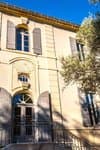
The chapels path
From the Saint-Gabriel chapel to Saint-Peire d'Entremonts, discover this part of the Regional Natural Park, east gate of the Alpilles. Along the way, follow the traces of transhumance on the outskirts of Saint-Gabriel, enjoy a rich and varied biodiversity on the heights of Planet, then finally, let yourself be charmed by the tranquillity of the Lèque valley and the beauty of its landscapes.
9 points of interest

Troupeau de chèvres du Rove autour de Saint-Gabriel - ©Lionel Roux  Elevage et pastoralisme
Elevage et pastoralismeThe herds against the fire
The landscape of the Alpilles has been shaped by centuries of grazing. In the mountains, sheep and goat flocks or cattle herds all play an important part in the maintenance of the natural area: by eating the grass and some of the tree sprouts and shrubs, they slow down the overrunning. The area thus remains open and grasslands are maintained. This practice helps to protect the forest against fire and the preservation of the Mediterranean biodiversity.

Vue d'une tour du castrum - ©Jason Gaydier - PNR Alpilles  Patrimony and history
Patrimony and historyThe castrum of Saint-Gabriel
Under the authority of the counts of Provence, a castrum (fortified site) was built in the 13th century to defend Tarascon and the traffic routes. The number of soldiers present varies depending on the events until the end of the 16th century. Today, only the main tower and vestiges remain. The facing of the tower is adorned with a remarkable boss. On the blocks of stones, the different signs makes it possible to identify the stone carver and to pay him accordingly.
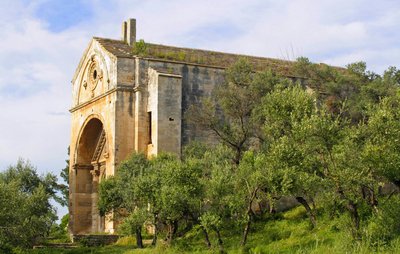
Vue sur la chapelle Saint-Gabriel - ©Bruno Schickélé  Patrimony and history
Patrimony and historySaint-Gabriel chapel
In the early Middle Ages, a first church was erected in the place of a former place of pagan worship. Dedicated to the archangel Gabriel, it is a milestone in the Way of St James trail. The present chapel was built in the 12th century and reflects the splendour of early Romanesque art in Provence, as shown in its architecture: its Antique façade, monumental gate, sculpted friezes, or its oculus decorated with symbols of the four Evangelists.
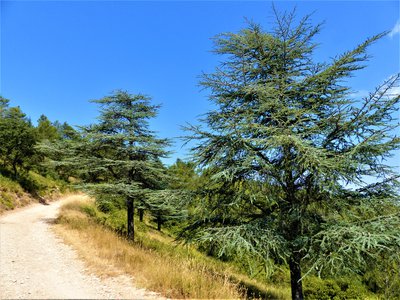
Cèdres de l'Atlas - ©Rémi Sérange - PNR Alpilles  Flora
FloraAtlas cedar
The Atlas cedar is a coniferous tree of the Pinaceae family. It is native to the Atlas, mountainous massif of North Africa. First introduced in public gardens, it grows naturally today in the south of France. Also known as blue cedar or silver cedar, Atlas cedar is a tree with a majestic and imposing look that can reach a height of 30 to 40 meters. If its shape is pyramidal when it is young, it becomes tabular when adult.
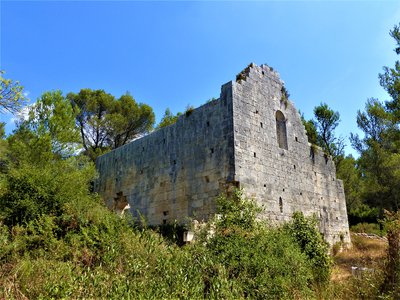
Chapelle Saint-Peire - ©Rémi Sérange - PNR Alpilles  Patrimony and history
Patrimony and historySaint-Peire-d'Entremonts Chapel
Located in the Lèque valley, the Saint-Peire-d'Entremonts chapel is a medieval building of the twelfth century. This priory was affiliated to the Saint-Gilles Abbey and then to the Chartreuse d'Avignon. The first mention of this chapel dates back to 1213. The remains of buildings are currently being restored by the association "Apier ou le Mur à des Oreilles" which organizes volunteer projects. ;

Flambé vu de haut - ©Rémi Sérange - PNR Alpilles  Fauna
FaunaLe Flambé
The flambé is a large triangular butterfly, with a wingspan of 50 to 70 mm (the male is smaller than the female) and recognizable by its large hovering flights. Its name comes from the coloring of its wings by black bands. Flambé lays eggs from April to August. The black larva becomes green after the second moulting. It winters as a chrysalis, then flies from late March to September. There is one, two, or three generations a year.
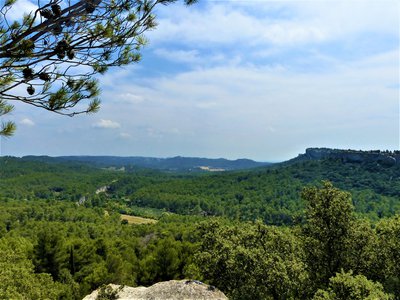
Vue sur le vallon de la Lèque - ©Rémi Sérange - PNR Alpilles  Panorama
PanoramaView on the Lèque Valley and the Mont Valencia
A bird's eye view allows to observe, the Lèque valley with its isolated dwellings and its large pine forest that extends from north to south. Further, this decor gives way to agricultural plots that go to the Val d'Enfer des Baux-de-Provence, and in clear weather, it is possible to see the summit of Opies, the Alpilles highest point. On the right stand two reliefs that close this valley, including Mount Valencia and its 234 m.
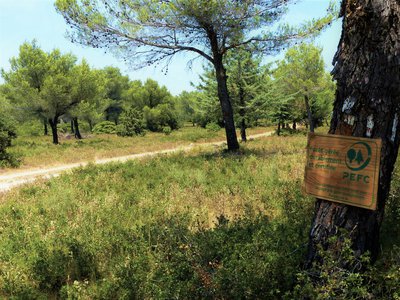
Panneau témoin d'une gestion forestière durable - ©Rémi Sérange - PNR Alpilles  Savoir-faire
Savoir-fairePEFC Sustainable Forest
PEFC is an international association established in 1999. Her goal is to fight for the forests to be respected and well maintained. For this, it has put in place precise rules, enshrined in the principles of sustainable development, for the wood chain actors : from the forester who maintains his forest to the store that sells wood or wooden objects. The association then ensures that these rules are respected. Today, one in three French forests is PEFC certified.
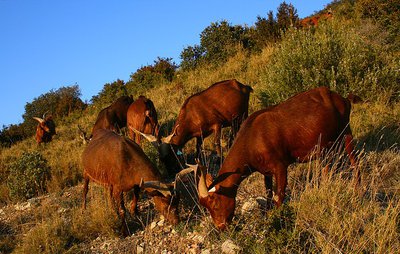
Les chèvres du Rove en pâture - ©Patrick Fabre - Maison de la Transhumance  Elevage et pastoralisme
Elevage et pastoralismeThe Rove goat
The Rove goat is a countryside breed, easily recognizable with his lyre-shaped horns. It is generally found within large sheep flocks of Provence, which in summer, transhumance on foot towards the Alps. They had multiple roles: leading the sheep flock, feeding lambs, food subsistence for shepherds with goat milk and goat meat. After nearly disappearing in the 1970s, the breed now exceeds 10 000 goats.
Description
From the starting point, pass the barrier and follow the path on the left marked PR. At the crossroads, continue following the sign "Chapelle St-Gabriel 0.8 km".
1- At the sight of Castrum, turn left to the Saint Gabriel chapel. Go back to point # 1 and turn left. At the fork, climb the right path marked PR. Continue for 1.2 km.
2- At the junction, continue to the left following the sign "St-Etienne du Grès 5.3 km". Follow this marked path GR® on 1,6 km, by passing by 2 tanks
3- At the crossroads, go down the path still tagged GR®. Pass a barrier and join a crossing with a cistern and houses nearby.
4- Continue straight on the marked path PR, following the sign "Fontvieille 5.1 km". Pass the chapel St-Peire, then, at the crossroads, take the path on the right. Continue for 1 km.
5- Go on the right path marked PR, following the sign "Chapelle St-Gabriel 8.4 km". Climb the path to the left. 100 m further, leave the bend on your right and continue passing under the fig tree Follow this marked path for 1 km.
6- At the crossroads, turn left and continue for 500 m. At the cistern with a trough, continue straight on the unmarked path. Make 600 m with a left turn, then a right.
7- Find the marked path PR, follow it on the right, then 50 m further turn left. At the next crossroads, take the path marked PR on the right. Get off, then go up the small valley.
8- At the crossing, continue on the same road, always signposted PR. Follow it for 800 m until the "T" crossing. Take the right path for 800 m as well. Back to point n°2, turn left, following the sign "Chapel St Gabriel 2 km" Follow this marked path GR® on 1 km, then join the first junction. Turn left and return to the starting point.
- Departure : Parking du Planet, along the D33
- Arrival : Parking du Planet, along the D33
- Towns crossed : Tarascon, Saint-Étienne-du-Grès, and Fontvieille
Forecast
Altimetric profile
Recommandations
For your safety, and for the preservation of forest areas, access to natural areas is regulated from June to September. Inquire during the summer period on 08 11 20 13 13 (price of a local call) or on www.bouches-du-rhone.pref.gouv.fr Download the application for free MYPROVENCE ENVIE DE BALADE (available on Appstore and Android Market).
Information desks
Bureau d'information touristique (BIT) de Tarascon en Provence
62 rue des Halles, 13150 Tarascon en Provence
House of the Alpilles Regional Nature Park
2, boulevard Marceau, 13210 Saint-Rémy-de-Provence
Located in the heart of the city centre of Saint-Rémy-de-Provence, the House of the Alpilles Nature Park welcomes you to its completely renovated premises. This new vibrant place is multifunctional: it accommodates the Park's engineering team but also has a public reception space and showrooms. A true resource centre of the Park's heritage, it aims to support and promote locals, visitors and tourists on all 16 municipalities of the Park.
Open Monday to Friday, from 9 am at 12:30 pm and from 1:30 pm to 5 pm.
Free admission.
Transport
Access and parking
From the D33, join the car park 800m after the Saint-Gabriel chapel towards Fontvieille.
Parking :
Access
- Emergency number :
- 114
Report a problem or an error
If you have found an error on this page or if you have noticed any problems during your hike, please report them to us here:


